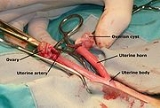
Veterinary surgery
Encyclopedia
Veterinary surgery is surgery
performed on animals by veterinarian
s. Advanced surgical procedures such as joint replacement (total hip, knee and elbow replacement), fracture repair, ACL treatment, oncologic (cancer) surgery, herniated disc treatment, complicated gastrointestinal or urogenital procedures, kidney transplant, skin grafts, complicated wound management, minimally invasive procedures (arthroscopy, laparoscopy, thoracoscopy), etc. are performed by Veterinary Surgeons
(as registered in their jurisdiction). Most general practice veterinarians perform routine surgery [neuters (spay and castration), minor mass excisions, etc.], some also perform additional procedures.
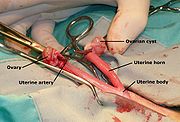 The goal of veterinary surgery may be quite different in pets
The goal of veterinary surgery may be quite different in pets
and in farm animals. In the former, situation is a bit like in human beings, and more and more complex operations are performed, with sophisticated anaesthesia techniques. In the latter, the cost of the operation must not exceed the economic benefit in surgically treating the illness.
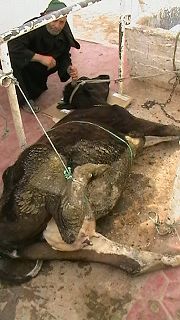
and Europe
, veterinary surgery is one of 20 veterinary specialties
recognized by the American Veterinary Medical Association
respectively the European Board of Veterinary Specialisation . Those wishing to become board certified must undergo three years of intensive training in a residency program under direct supervision of Board Certified Veterinary Surgeons, including performance of a large number of surgical procedures in such categories as abdominal surgery
, surgical treatment of angular limb deformities, arthroscopic surgery
, surgery of the foot, fracture fixation, ophthalmic surgery
, urogenital surgery, and upper respiratory surgery, etc. Once the minimum requirements of training are met residents are required to pass a rigorous certification examination before being admitted as members (Diplomates) of the American College of Veterinary Surgeons or European College of Veterinary Surgery
in animals has many similarities to human anesthesia, but some differences as well. Local anesthesia
is primarily used for wound closure and removal of small tumors. Lidocaine
, mepivacaine
, and bupivacaine
are the most commonly used local anesthetic
s used in veterinary medicine. Sedation
without general anesthesia is used for more involved procedures. Sedatives commonly used include acepromazine
, hydromorphine
, midazolam
, diazepam
, xylazine
, and medetomidine
. α2
agonist
s like xylazine and medetomidine are especially useful because they can be reversed, xylazine by yohimbine
and medetomidine by atipamezole
. Xylazine is approved for use in dogs, cats, horses, deer
, and elk
in the United States, while medetomidine is only approved for dogs. Most surgeries in ruminant
s can be performed with regional anesthesia.
General anesthesia is commonly used in animals for major surgery. Animals are often premedicated intravenously or intramuscularly with a sedative, analgesic
, and anticholinergic
agent (dogs frequently receive buprenorphine
, acepromazine, and glycopyrrolate
). The next step is induction, usually with an intravenous drug. Dogs and cats commonly receive thiopental (no longer allowed in the UK), ketamine
with diazepam, tiletamine
with zolazepam
(usually just in cats), and/or propofol
. Alfaxalone
is a steroid
anaesthetic used in many practices in the UK to induce anaesthesia in cats and sometimes dogs. It is similar in physiological effect but different in composition to the now withdrawn Saffan. Horses commonly receive thiopental and guaifenesin
. Following induction, the animal is intubated
with an endotracheal tube and maintained on a gas anesthetic. The most common gas anesthetics in use in veterinary medicine are isoflurane
, enflurane
, and halothane
, although desflurane
and sevoflurane
are becoming more popular due to rapid induction and recovery.
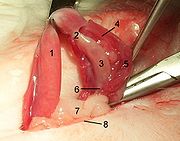 One of the most common elective surgical procedures in animals is neutering. Neutering in animals describes spaying or castration (also please see castration
One of the most common elective surgical procedures in animals is neutering. Neutering in animals describes spaying or castration (also please see castration
). To spay (medical term: ovariectomy
or ovario-hysterectomy) is to completely remove the ovaries
and often the uterus
of a female animal. In a dog
this is accomplished through a ventral midline incision into the abdomen
. In a cat
this is accomplished either by a ventral midline abdomenal incision, or by a flank incision (more common in the UK). With an ovariectomy
ligatures
are placed on the blood vessels above and below the ovary and the organ is removed. With an ovariohysterectomy the ligaments of the uterus and ovaries are broken down and the blood vessels are ligated
and both organs are removed. The body wall, subcutis, and skin are sutured. To castrate (medical term: orchidectomy) is to remove the testicle
s of a male animal. Different techniques are used depending on the type of animal, including ligation of the spermatic cord
with suture material, placing a band around the cord, or crushing the cord with a Burdizzo
.
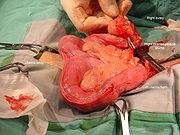 Neutering is usually performed to prevent breeding or prevent unwanted behavior or future medical problems. Please see spaying and neutering for more information on the advantages and disadvantages of this procedure. Neutering is also performed as an emergency procedure to treat pyometra
Neutering is usually performed to prevent breeding or prevent unwanted behavior or future medical problems. Please see spaying and neutering for more information on the advantages and disadvantages of this procedure. Neutering is also performed as an emergency procedure to treat pyometra
and testicular torsion
, and it is used to treat ovarian
, uterine
, and testicular cancer
. It is also recommended in cases of cryptorchidism
to prevent torsion and malignant transformation
of the testicles.
Other common elective surgical procedures in the USA are declawing in cats (onychectomy
), ropping (animal)|ear-cropping in dogs, and tail docking
in dogs and horse
s. These procedures are illegal in some countries (declawing is illegal and tail docking is only allowed in working dogs in the UK) and face ethical challenges in others. Declawing consists of removal of the distal phalanges
using either a scalpel
, scissors
or laser
.
Laser surgery
offers a number of benefits,
, including reduced risk of infection
, less post-operative pain and swelling
, reduced bleeding
and improved visibility of the surgical field. Better hemostasis
and visibility can in some cases minimize the need for anesthesia
and/or reduce overall surgical time.
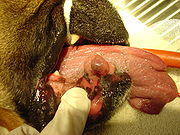 Common dental surgical procedures:
Common dental surgical procedures:
s are a common occurrence. Common skin tumors include lipoma
s, mast cell tumors, melanoma
s, squamous cell carcinoma
s, basal cell carcinoma
s, fibrosarcoma
s, and histiocytoma
s. Skin tumors are removed through either simple incisions or through plastic surgery
. Common oral tumors include melanomas, fibrosarcomas, squamous cell carcinomas, which are removed with as much surrounding tissue as possible, including parts of the mandible
and maxilla
. Other types of cancer requiring surgery include osteosarcoma
, stomach and intestinal tumors, splenic masses
, and urinary bladder
tumors.
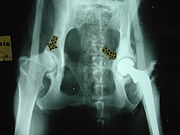
s are commonly performed in dogs, cats, horses, sheep, and cattle. Usually it is done as an emergency surgery due to difficulties in the birthing process. Certain dog breeds such as Bulldog
s often need to have this surgery because of the size of the puppy's head relative to the width of the bitch's birth canal.
or gastric dilatation volvulus (GDV) is a common condition where the stomach fills with gas and commonly twists. If the stomach is torsed it requires immediate surgical intervention to prevent necrosis
of the stomach wall. After radiographs to confirm the GDV and blood tests to determine the lactate and general health of the dog, surgical intervention is required. The stomach is put back into its normal position, deflated and tacked (gastropexy
) to the body wall. Sometimes a splenectomy
or partial gastrectomy
is also required.
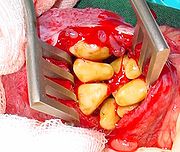 A cystotomy is a surgical opening of the urinary bladder
A cystotomy is a surgical opening of the urinary bladder
. It is commonly performed in dogs and cats to remove bladder stone
s or tumors.
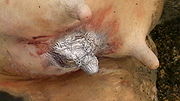 Bite wounds from other animals (and rarely humans) are a common occurrence. Wounds from objects that the animal may step on or run into are also common. Usually these wounds are simple lacerations that can be easily cleaned and sutured, sometimes using a local anesthetic
Bite wounds from other animals (and rarely humans) are a common occurrence. Wounds from objects that the animal may step on or run into are also common. Usually these wounds are simple lacerations that can be easily cleaned and sutured, sometimes using a local anesthetic
. Bite wounds, however, involve compressive and tensile forces in addition to shearing forces, and can cause separation of the skin from the underlying tissue and avulsion
of underlying muscles. Deep puncture wounds are especially prone to infection. Deeper wounds are assessed under anesthesia
and explored, lavage
d, and debrided
. Primary wound closure is used if all remaining tissue is healthy and free of contamination. Small puncture wounds may be left open, bandaged, and allowed to heal
without surgery. A third alternative is delayed primary closure, which involves bandaging and reevaluation and surgery in three to five days.
Wounds occurring in the udder
and teats of cows are more difficult to repair, due to the difficult access and sensitivity of the organ, and because deep anaesthesia may not be applied to bovines. But some practitioners have acquired a great experience in dealing them.
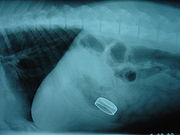 A variety of objects are commonly swallowed by dogs, cats, and cattle. Foreign bodies
A variety of objects are commonly swallowed by dogs, cats, and cattle. Foreign bodies
can cause obstruction of the gastrointestinal tract
causing severe vomiting and resulting electrolyte
imbalances. The stomach (gastrotomy) or intestine (enterotomy) can be surgically opened to remove the foreign body. Necrotic intestine can be removed (enterectomy) and repaired with intestinal anastomosis. Foreign bodies can also be removed by endoscopy
. The condition in cattle is known as hardware disease
.
Surgery
Surgery is an ancient medical specialty that uses operative manual and instrumental techniques on a patient to investigate and/or treat a pathological condition such as disease or injury, or to help improve bodily function or appearance.An act of performing surgery may be called a surgical...
performed on animals by veterinarian
Veterinarian
A veterinary physician, colloquially called a vet, shortened from veterinarian or veterinary surgeon , is a professional who treats disease, disorder and injury in animals....
s. Advanced surgical procedures such as joint replacement (total hip, knee and elbow replacement), fracture repair, ACL treatment, oncologic (cancer) surgery, herniated disc treatment, complicated gastrointestinal or urogenital procedures, kidney transplant, skin grafts, complicated wound management, minimally invasive procedures (arthroscopy, laparoscopy, thoracoscopy), etc. are performed by Veterinary Surgeons
(as registered in their jurisdiction). Most general practice veterinarians perform routine surgery [neuters (spay and castration), minor mass excisions, etc.], some also perform additional procedures.

PETS
PETS may be an acronym for:* Pet Travel Scheme, which allows animals to travel internationally without quarantine* Pets Evacuation and Transportation Standards Act...
and in farm animals. In the former, situation is a bit like in human beings, and more and more complex operations are performed, with sophisticated anaesthesia techniques. In the latter, the cost of the operation must not exceed the economic benefit in surgically treating the illness.

Specialization in surgery
In the United StatesUnited States
The United States of America is a federal constitutional republic comprising fifty states and a federal district...
and Europe
Europe
Europe is, by convention, one of the world's seven continents. Comprising the westernmost peninsula of Eurasia, Europe is generally 'divided' from Asia to its east by the watershed divides of the Ural and Caucasus Mountains, the Ural River, the Caspian and Black Seas, and the waterways connecting...
, veterinary surgery is one of 20 veterinary specialties
Veterinary specialties
A veterinary specialist is a veterinarian who specializes in a clinical field of veterinary medicine."A veterinary specialist, as recognized by the AVMA, is a graduate veterinarian who has successfully completed the process of board certification in an AVMA-recognized veterinary specialty...
recognized by the American Veterinary Medical Association
American Veterinary Medical Association
The American Veterinary Medical Association , founded in 1863, is a not-for-profit association representing more than 81,500 U.S. veterinarians working in private and corporate practice, government, industry, academia, and uniformed services....
respectively the European Board of Veterinary Specialisation . Those wishing to become board certified must undergo three years of intensive training in a residency program under direct supervision of Board Certified Veterinary Surgeons, including performance of a large number of surgical procedures in such categories as abdominal surgery
Abdominal surgery
The term abdominal surgery broadly covers surgical procedures that involve opening the abdomen. Surgery of each abdominal organ is dealt with separately in connection with the description of that organ Diseases affecting the abdominal cavity are dealt with generally under their own names The term...
, surgical treatment of angular limb deformities, arthroscopic surgery
Arthroscopy
Arthroscopy is a minimally invasive surgical procedure in which an examination and sometimes treatment of damage of the interior of a joint is performed using an arthroscope, a type of endoscope that is inserted into the joint through a small incision...
, surgery of the foot, fracture fixation, ophthalmic surgery
Eye surgery
Eye surgery, also known as orogolomistician surgery or ocular surgery, is surgery performed on the eye or its adnexa, typically by an ophthalmologist.-Preparation and precautions:...
, urogenital surgery, and upper respiratory surgery, etc. Once the minimum requirements of training are met residents are required to pass a rigorous certification examination before being admitted as members (Diplomates) of the American College of Veterinary Surgeons or European College of Veterinary Surgery
Veterinary anesthesia
AnesthesiaAnesthesia
Anesthesia, or anaesthesia , traditionally meant the condition of having sensation blocked or temporarily taken away...
in animals has many similarities to human anesthesia, but some differences as well. Local anesthesia
Local anesthesia
Local anesthesia is any technique to induce the absence of sensation in part of the body, generally for the aim of inducing local analgesia, that is, local insensitivity to pain, although other local senses may be affected as well. It allows patients to undergo surgical and dental procedures with...
is primarily used for wound closure and removal of small tumors. Lidocaine
Lidocaine
Lidocaine , Xylocaine, or lignocaine is a common local anesthetic and antiarrhythmic drug. Lidocaine is used topically to relieve itching, burning and pain from skin inflammations, injected as a dental anesthetic or as a local anesthetic for minor surgery.- History :Lidocaine, the first amino...
, mepivacaine
Mepivacaine
Mepivacaine is a local anesthetic of the amide type. Mepivacaine has a reasonably rapid onset and medium duration of action and is marketed under various trade names including Carbocaine and Polocaine.Mepivacaine became available in the United States in the 1960s.Mepivacaine is used in any...
, and bupivacaine
Bupivacaine
Bupivacaine is a local anaesthetic drug belonging to the amino amide group. AstraZeneca commonly markets it under various trade names, including Marcain, Marcaine, Sensorcaine and Vivacaine.-Indications:...
are the most commonly used local anesthetic
Local anesthetic
A local anesthetic is a drug that causes reversible local anesthesia, generally for the aim of having local analgesic effect, that is, inducing absence of pain sensation, although other local senses are often affected as well...
s used in veterinary medicine. Sedation
Sedation
Sedation is the reduction of irritability or agitation by administration of sedative drugs, generally to facilitate a medical procedure or diagnostic procedure...
without general anesthesia is used for more involved procedures. Sedatives commonly used include acepromazine
Acepromazine
Acepromazine or acetylpromazine is a phenothiazine derivative antipsychotic drug. It was first used in humans in the 1950s, but is now little used in humans...
, hydromorphine
Hydromorphone
Hydromorphone, a more common synonym for dihydromorphinone, commonly a hydrochloride is a very potent centrally-acting analgesic drug of the opioid class. It is a derivative of morphine, to be specific, a hydrogenated ketone thereof and, therefore, a semi-synthetic drug...
, midazolam
Midazolam
Midazolam is a short-acting drug in the benzodiazepine class developed by Hoffmann-La Roche in the 1970s. The drug is used for treatment of acute seizures, moderate to severe insomnia, and for inducing sedation and amnesia before medical procedures. It possesses profoundly potent anxiolytic,...
, diazepam
Diazepam
Diazepam , first marketed as Valium by Hoffmann-La Roche is a benzodiazepine drug. Diazepam is also marketed in Australia as Antenex. It is commonly used for treating anxiety, insomnia, seizures including status epilepticus, muscle spasms , restless legs syndrome, alcohol withdrawal,...
, xylazine
Xylazine
Xylazine is a drug that is used for sedation, anesthesia, muscle relaxation, and analgesia in animals such as horses, cattle and other non-human mammals. An analogue of clonidine, it is an agonist at the α2 class of adrenergic receptor....
, and medetomidine
Medetomidine
Medetomidine is a synthetic drug used as both a surgical anesthetic and analgesic often used as the hydrochloride salt medetomidine hydrochloride. It is a crystalline white alpha-two adrenergic agonist that can be administered as an intravenous drug solution with sterile water...
. α2
Adrenergic receptor
The adrenergic receptors are a class of metabotropic G protein-coupled receptors that are targets of the catecholamines, especially noradrenaline and adrenaline ....
agonist
Agonist
An agonist is a chemical that binds to a receptor of a cell and triggers a response by that cell. Agonists often mimic the action of a naturally occurring substance...
s like xylazine and medetomidine are especially useful because they can be reversed, xylazine by yohimbine
Yohimbine
Yohimbine is an alkaloid with stimulant and aphrodisiac effects found naturally in Pausinystalia yohimbe . It is also found naturally in Rauwolfia serpentina , Alchornea floribunda , along with several other active alkaloids...
and medetomidine by atipamezole
Atipamezole
Atipamezole is a synthetic alpha2-adrenergic antagonist, indicated for the reversal of the sedative and analgesic effects of dexmedetomidine and medetomidine in dogs. It has also been researched in humans as a potential anti-Parkinsonian drug.-External links:*...
. Xylazine is approved for use in dogs, cats, horses, deer
Deer
Deer are the ruminant mammals forming the family Cervidae. Species in the Cervidae family include white-tailed deer, elk, moose, red deer, reindeer, fallow deer, roe deer and chital. Male deer of all species and female reindeer grow and shed new antlers each year...
, and elk
Elk
The Elk is the large deer, also called Cervus canadensis or wapiti, of North America and eastern Asia.Elk may also refer to:Other antlered mammals:...
in the United States, while medetomidine is only approved for dogs. Most surgeries in ruminant
Ruminant
A ruminant is a mammal of the order Artiodactyla that digests plant-based food by initially softening it within the animal's first compartment of the stomach, principally through bacterial actions, then regurgitating the semi-digested mass, now known as cud, and chewing it again...
s can be performed with regional anesthesia.
General anesthesia is commonly used in animals for major surgery. Animals are often premedicated intravenously or intramuscularly with a sedative, analgesic
Analgesic
An analgesic is any member of the group of drugs used to relieve pain . The word analgesic derives from Greek an- and algos ....
, and anticholinergic
Anticholinergic
An anticholinergic agent is a substance that blocks the neurotransmitter acetylcholine in the central and the peripheral nervous system. An example of an anticholinergic is dicycloverine, and the classic example is atropine....
agent (dogs frequently receive buprenorphine
Buprenorphine
Buprenorphine is a semi-synthetic opioid that is used...
, acepromazine, and glycopyrrolate
Glycopyrrolate
Glycopyrrolate is a medication of the muscarinic anticholinergic group. It does not cross the blood brain barrier and consequently has no to few central effects. It is a synthetic quaternary amine...
). The next step is induction, usually with an intravenous drug. Dogs and cats commonly receive thiopental (no longer allowed in the UK), ketamine
Ketamine
Ketamine is a drug used in human and veterinary medicine. Its hydrochloride salt is sold as Ketanest, Ketaset, and Ketalar. Pharmacologically, ketamine is classified as an NMDA receptor antagonist...
with diazepam, tiletamine
Tiletamine
Tiletamine is a dissociative anesthetic and pharmacologically classified as an NMDA receptor antagonist. It is related chemically and pharmacologically to other anesthetics in this family such as ketamine and phencyclidine...
with zolazepam
Zolazepam
Zolazepam was discoverd by a team at Parke-Davis in the 1960s. is a pyrazolodiazepinone derivative structurally related to the benzodiazepine drugs, which is used as an anaesthetic for a wide range of animals in veterinary medicine...
(usually just in cats), and/or propofol
Propofol
Propofol is a short-acting, intravenously administered hypnotic agent. Its uses include the induction and maintenance of general anesthesia, sedation for mechanically ventilated adults, and procedural sedation. Propofol is also commonly used in veterinary medicine...
. Alfaxalone
Alfaxalone
Alfaxalone is a neurosteroid general anaesthetic.It is one of the constituents of althesin.It is used in veterinary practice under the tradename Alfaxan....
is a steroid
Steroid
A steroid is a type of organic compound that contains a characteristic arrangement of four cycloalkane rings that are joined to each other. Examples of steroids include the dietary fat cholesterol, the sex hormones estradiol and testosterone, and the anti-inflammatory drug dexamethasone.The core...
anaesthetic used in many practices in the UK to induce anaesthesia in cats and sometimes dogs. It is similar in physiological effect but different in composition to the now withdrawn Saffan. Horses commonly receive thiopental and guaifenesin
Guaifenesin
Guaifenesin INN or guaiphenesin , also glyceryl guaiacolate, is an expectorant drug sold over the counter and usually taken by mouth to assist the bringing up of phlegm from the airways in acute respiratory tract infections.-History:Similar medicines derived from the guaiac tree were in use as a...
. Following induction, the animal is intubated
Intubation
Tracheal intubation, usually simply referred to as intubation, is the placement of a flexible plastic or rubber tube into the trachea to maintain an open airway or to serve as a conduit through which to administer certain drugs...
with an endotracheal tube and maintained on a gas anesthetic. The most common gas anesthetics in use in veterinary medicine are isoflurane
Isoflurane
Isoflurane is a halogenated ether used for inhalational anesthesia. Together with enflurane and halothane, it replaced the flammable ethers used in the pioneer days of surgery. Its name comes from being a structural isomer of enflurane, hence they have the same empirical formula...
, enflurane
Enflurane
Enflurane is a halogenated ether that was commonly used for inhalational anesthesia during the 1970s and 1980s. Developed by Ross Terrell in 1963, it was first used clinically in 1966....
, and halothane
Halothane
Halothane is an inhalational general anesthetic. Its IUPAC name is 2-bromo-2-chloro-1,1,1-trifluoroethane. It is the only inhalational anesthetic agent containing a bromine atom; there are several other halogenated anesthesia agents which lack the bromine atom and do contain the fluorine and...
, although desflurane
Desflurane
Desflurane is a highly fluorinated methyl ethyl ether used for maintenance of general anesthesia. Like halothane, enflurane and isoflurane, it is a racemic mixture of and optical isomers...
and sevoflurane
Sevoflurane
Sevoflurane , also called fluoromethyl hexafluoroisopropyl ether, is a sweet-smelling, nonflammable, highly fluorinated methyl isopropyl ether used for induction and maintenance of general anesthesia. Together with desflurane, it is replacing isoflurane and halothane in modern anesthesiology...
are becoming more popular due to rapid induction and recovery.
Elective procedures

Castration
Castration is any action, surgical, chemical, or otherwise, by which a male loses the functions of the testicles or a female loses the functions of the ovaries.-Humans:...
). To spay (medical term: ovariectomy
Oophorectomy
Oophorectomy is the surgical removal of an ovary or ovaries. The surgery is also called ovariectomy, but this term has been traditionally used in basic science research describing the surgical removal of ovaries in laboratory animals...
or ovario-hysterectomy) is to completely remove the ovaries
Ovary
The ovary is an ovum-producing reproductive organ, often found in pairs as part of the vertebrate female reproductive system. Ovaries in anatomically female individuals are analogous to testes in anatomically male individuals, in that they are both gonads and endocrine glands.-Human anatomy:Ovaries...
and often the uterus
Uterus
The uterus or womb is a major female hormone-responsive reproductive sex organ of most mammals including humans. One end, the cervix, opens into the vagina, while the other is connected to one or both fallopian tubes, depending on the species...
of a female animal. In a dog
Dog
The domestic dog is a domesticated form of the gray wolf, a member of the Canidae family of the order Carnivora. The term is used for both feral and pet varieties. The dog may have been the first animal to be domesticated, and has been the most widely kept working, hunting, and companion animal in...
this is accomplished through a ventral midline incision into the abdomen
Abdomen
In vertebrates such as mammals the abdomen constitutes the part of the body between the thorax and pelvis. The region enclosed by the abdomen is termed the abdominal cavity...
. In a cat
Cat
The cat , also known as the domestic cat or housecat to distinguish it from other felids and felines, is a small, usually furry, domesticated, carnivorous mammal that is valued by humans for its companionship and for its ability to hunt vermin and household pests...
this is accomplished either by a ventral midline abdomenal incision, or by a flank incision (more common in the UK). With an ovariectomy
Oophorectomy
Oophorectomy is the surgical removal of an ovary or ovaries. The surgery is also called ovariectomy, but this term has been traditionally used in basic science research describing the surgical removal of ovaries in laboratory animals...
ligatures
Ligature (medicine)
In surgery or medical procedure, a ligature consists of a piece of thread tied around an anatomical structure, usually a blood vessel or another hollow structure to shut it off. With a blood vessel the surgeon will clamp the vessel perpendicular to the axis of the artery or vein with a hemostat,...
are placed on the blood vessels above and below the ovary and the organ is removed. With an ovariohysterectomy the ligaments of the uterus and ovaries are broken down and the blood vessels are ligated
Ligature (medicine)
In surgery or medical procedure, a ligature consists of a piece of thread tied around an anatomical structure, usually a blood vessel or another hollow structure to shut it off. With a blood vessel the surgeon will clamp the vessel perpendicular to the axis of the artery or vein with a hemostat,...
and both organs are removed. The body wall, subcutis, and skin are sutured. To castrate (medical term: orchidectomy) is to remove the testicle
Testicle
The testicle is the male gonad in animals. Like the ovaries to which they are homologous, testes are components of both the reproductive system and the endocrine system...
s of a male animal. Different techniques are used depending on the type of animal, including ligation of the spermatic cord
Spermatic cord
The spermatic cord is the name given to the cord-like structure in males formed by the ductus deferens and surrounding tissue that run from the abdomen down to each testicle.-Contents of spermatic cord:...
with suture material, placing a band around the cord, or crushing the cord with a Burdizzo
Burdizzo
The Burdizzo is a castration device which employs a large clamp designed to break the blood vessels leading into the testicles. Once the blood supply to the testicles is lost, testicular necrosis occurs, and the testicles shrink, soften, and eventually deteriorate completely...
.

Pyometra
Pyometra is a disease of the uterus most commonly seen in female dogs, but also seen in female cats , rabbits, ferrets, rats and guinea pigs. Pyometra is an important disease to be aware of for any dog owner because of the sudden nature of the disease and the deadly consequences if left untreated...
and testicular torsion
Testicular torsion
Testicular torsion is when the spermatic cord to a testicle twists, cutting off the blood supply. The most common symptom is acute testicular pain and the most common underlying cause is a congenital malformation known as a "bell-clapper deformity". The diagnosis is often made clinically but if it...
, and it is used to treat ovarian
Ovarian cancer
Ovarian cancer is a cancerous growth arising from the ovary. Symptoms are frequently very subtle early on and may include: bloating, pelvic pain, difficulty eating and frequent urination, and are easily confused with other illnesses....
, uterine
Uterine cancer
The term uterine cancer may refer to any of several different types of cancer which occur in the uterus, namely:*Uterine sarcomas: sarcomas of the myometrium, or muscular layer of the uterus, are most commonly leiomyosarcomas.*Endometrial cancer:...
, and testicular cancer
Testicular cancer
Testicular cancer is cancer that develops in the testicles, a part of the male reproductive system.In the United States, between 7,500 and 8,000 diagnoses of testicular cancer are made each year. In the UK, approximately 2,000 men are diagnosed each year. Over his lifetime, a man's risk of...
. It is also recommended in cases of cryptorchidism
Cryptorchidism
Cryptorchidism is the absence of one or both testes from the scrotum. It is the most common birth defect regarding male genitalia. In unique cases, cryptorchidism can develop later in life, often as late as young adulthood. About 3% of full-term and 30% of premature infant boys are born with at...
to prevent torsion and malignant transformation
Malignant transformation
Malignant transformation is the process by which cells acquire the properties of cancer. This may occur as a primary process in normal tissue, or secondarily as malignant degeneration of a previously existing benign tumor....
of the testicles.
Other common elective surgical procedures in the USA are declawing in cats (onychectomy
Onychectomy
Onychectomy, popularly known as declawing, is an operation to surgically remove an animal's claws by means of amputating all or part of the distal phalanx, or end bones, of the animal's toes. It is performed most often on household cats, though occasionally on other animals such as circus lions or...
), ropping (animal)|ear-cropping in dogs, and tail docking
Docking (animals)
Docking is the removal of portions of an animal's tail. While space docking and bobbing are more commonly used to refer to removal of the tail, the term cropping is used in reference to the ears. Tail docking occurs in one of two ways. The first involves constricting the blood supply to the tail...
in dogs and horse
Horse
The horse is one of two extant subspecies of Equus ferus, or the wild horse. It is a single-hooved mammal belonging to the taxonomic family Equidae. The horse has evolved over the past 45 to 55 million years from a small multi-toed creature into the large, single-toed animal of today...
s. These procedures are illegal in some countries (declawing is illegal and tail docking is only allowed in working dogs in the UK) and face ethical challenges in others. Declawing consists of removal of the distal phalanges
Distal phalanges
The distal or terminal phalanges are the terminal limb bones located at the tip of the digits...
using either a scalpel
Scalpel
A scalpel, or lancet, is a small and extremely sharp bladed instrument used for surgery, anatomical dissection, and various arts and crafts . Scalpels may be single-use disposable or re-usable. Re-usable scalpels can have attached, resharpenable blades or, more commonly, non-attached, replaceable...
, scissors
Scissors
Scissors are hand-operated cutting instruments. They consist of a pair of metal blades pivoted so that the sharpened edges slide against each other when the handles opposite to the pivot are closed. Scissors are used for cutting various thin materials, such as paper, cardboard, metal foil, thin...
or laser
Laser scalpel
A laser scalpel is a scalpel for surgery, cutting or ablating living biological tissue by the energy of laser light. In soft tissue laser surgery, a laser beam ablates or vaporizes the soft tissue with high water content....
.
Laser surgery
Soft tissue laser surgery
In soft tissue laser surgery, interaction of laser light with the soft tissue provides a special approach to surgery. A highly focused laser beam vaporizes the soft tissue with the high water content. Laser can make very small incisions when the beam is focused on the tissue...
offers a number of benefits,
, including reduced risk of infection
Infection
An infection is the colonization of a host organism by parasite species. Infecting parasites seek to use the host's resources to reproduce, often resulting in disease...
, less post-operative pain and swelling
Edema
Edema or oedema ; both words from the Greek , oídēma "swelling"), formerly known as dropsy or hydropsy, is an abnormal accumulation of fluid beneath the skin or in one or more cavities of the body that produces swelling...
, reduced bleeding
Bleeding
Bleeding, technically known as hemorrhaging or haemorrhaging is the loss of blood or blood escape from the circulatory system...
and improved visibility of the surgical field. Better hemostasis
Hemostasis
Hemostasis or haemostasis is a process which causes bleeding to stop, meaning to keep blood within a damaged blood vessel . Most of the time this includes blood changing from a liquid to a solid state. Intact blood vessels are central to moderating blood's tendency to clot...
and visibility can in some cases minimize the need for anesthesia
Anesthesia
Anesthesia, or anaesthesia , traditionally meant the condition of having sensation blocked or temporarily taken away...
and/or reduce overall surgical time.
Dental surgery

- Horses - Floating (grinding down) of uneven teeth edges and removal of wolf teethWolf toothWolf teeth are small peg-like teeth that sit just in front of to the first cheek teeth of horses and other equids. They are vestigial first premolars and the first cheek tooth is referred to as the second premolar even when wolf teeth are not present. Torbjörn Lundström in Sweden reported that...
. - Dogs - Dental prophylaxis is commonly performed to remove tartarCalculus (dental)In dentistry, calculus or tartar is a form of hardened dental plaque. It is caused by the continual accumulation of minerals from saliva on plaque on the teeth...
and treat periodontal diseasePeriodontal diseasePeriodontitis is a set of inflammatory diseases affecting the periodontium, i.e., the tissues that surround and support the teeth. Periodontitis involves progressive loss of the alveolar bone around the teeth, and if left untreated, can lead to the loosening and subsequent loss of teeth...
. This procedure is usually performed under anesthesia. Other common procedures include extraction of abscessed or broken teeth, extraction of deciduous teethDeciduous teethDeciduous teeth, otherwise known as reborner teeth, baby teeth, temporary teeth and primary teeth, are the first set of teeth in the growth development of humans and many other mammals. In some Asian countries they are referred to as fall teeth as they will eventually fall out, while in almost all...
, root canalRoot canalA root canal is the space within the root of a tooth. It is part of a naturally occurring space within a tooth that consists of the pulp chamber , the main canal, and more intricate anatomical branches that may connect the root canals to each other or to the surface of the root.-Root canal anatomy:...
s, and removal of gingival hyperplasia and epulidesEpulis fissuratumEpulis fissuratum is an oral pathologic condition that appears in the mouth as an overgrowth of fibrous connective tissue. Also referred to less commonly as inflammatory fibrous hyperplasia, denture epulis, and denture induced fibrous hyperplasia, it is associated with the edges of a denture that...
. - Cats - Dental prophylaxis as described above for the dog and treatment and extraction of teeth with feline odontoclastic resorptive lesionFeline odontoclastic resorptive lesionFeline odontoclastic resorptive lesions is a disease in cats characterized by resorption of the tooth by odontoclasts, cells similar to osteoclasts. A FORL is also known as a neck lesion, cervical neck lesion, cervical line erosion, feline caries, or feline cavity. It is one of the most common...
s (FORLs).
Surgical oncology
In older dogs and cats tumorTumor
A tumor or tumour is commonly used as a synonym for a neoplasm that appears enlarged in size. Tumor is not synonymous with cancer...
s are a common occurrence. Common skin tumors include lipoma
Lipoma
A lipoma is a benign tumor composed of adipose tissue. It is the most common form of soft tissue tumor. Lipomas are soft to the touch, usually movable, and are generally painless. Many lipomas are small but can enlarge to sizes greater than six centimeters. Lipomas are commonly found in adults...
s, mast cell tumors, melanoma
Melanoma
Melanoma is a malignant tumor of melanocytes. Melanocytes are cells that produce the dark pigment, melanin, which is responsible for the color of skin. They predominantly occur in skin, but are also found in other parts of the body, including the bowel and the eye...
s, squamous cell carcinoma
Squamous cell carcinoma
Squamous cell carcinoma , occasionally rendered as "squamous-cell carcinoma", is a histologically distinct form of cancer. It arises from the uncontrolled multiplication of malignant cells deriving from epithelium, or showing particular cytological or tissue architectural characteristics of...
s, basal cell carcinoma
Basal cell carcinoma
Basal-cell carcinoma is the most common type of skin cancer. It rarely metastasizes or kills. However, because it can cause significant destruction and disfigurement by invading surrounding tissues, it is still considered malignant. Statistically, approximately 3 out of 10 Caucasians may develop a...
s, fibrosarcoma
Fibrosarcoma
Fibrosarcoma is a malignant tumor derived from fibrous connective tissue and characterized by immature proliferating fibroblasts or undifferentiated anaplastic spindle cells.Usually in males ages 30 to 40. Originates in fibrous tissues of the bone. Invades long or flat bones such as femur, tibia,...
s, and histiocytoma
Histiocytoma (dog)
A histiocytoma in the dog is a benign tumor. It is an abnormal growth in the skin of histiocytes , a cell that is part of the immune system. A similar disease in humans, Hashimoto-Pritzker disease, is also a Langerhans cell histiocytosis. Dog breeds that may be more at risk for this tumor...
s. Skin tumors are removed through either simple incisions or through plastic surgery
Plastic surgery
Plastic surgery is a medical specialty concerned with the correction or restoration of form and function. Though cosmetic or aesthetic surgery is the best-known kind of plastic surgery, most plastic surgery is not cosmetic: plastic surgery includes many types of reconstructive surgery, hand...
. Common oral tumors include melanomas, fibrosarcomas, squamous cell carcinomas, which are removed with as much surrounding tissue as possible, including parts of the mandible
Mandible
The mandible pronunciation or inferior maxillary bone forms the lower jaw and holds the lower teeth in place...
and maxilla
Maxilla
The maxilla is a fusion of two bones along the palatal fissure that form the upper jaw. This is similar to the mandible , which is also a fusion of two halves at the mental symphysis. Sometimes The maxilla (plural: maxillae) is a fusion of two bones along the palatal fissure that form the upper...
. Other types of cancer requiring surgery include osteosarcoma
Osteosarcoma
Osteosarcoma is an aggressive cancerous neoplasm arising from primitive transformed cells of mesenchymal origin that exhibit osteoblastic differentiation and produce malignant osteoid...
, stomach and intestinal tumors, splenic masses
Splenectomy
A splenectomy is a surgical procedure that partially or completely removes the spleen.-Indications:The spleen, similar in structure to a large lymph node, acts as a blood filter. Current knowledge of its purpose includes the removal of old red blood cells and platelets, and the detection and fight...
, and urinary bladder
Urinary bladder
The urinary bladder is the organ that collects urine excreted by the kidneys before disposal by urination. A hollow muscular, and distensible organ, the bladder sits on the pelvic floor...
tumors.
Ophthalmic surgery
Common ophthalmic surgeries in animals include:- Enucleation of the eye to treat glaucomaGlaucomaGlaucoma is an eye disorder in which the optic nerve suffers damage, permanently damaging vision in the affected eye and progressing to complete blindness if untreated. It is often, but not always, associated with increased pressure of the fluid in the eye...
or eye proptosisEye proptosisEye proptosis is a condition resulting in forward displacement and entrapment of the eye from behind by the eyelids. The condition is also known as eye dislocation and eye luxation. It is a common result of head trauma and pressure exerted on the front of the neck too hard in dogs. Most commonly...
. - Cataract surgeryCataract surgeryCataract surgery is the removal of the natural lens of the eye that has developed an opacification, which is referred to as a cataract. Metabolic changes of the crystalline lens fibers over time lead to the development of the cataract and loss of transparency, causing impairment or loss of vision...
- EntropionEntropionEntropion is a medical condition in which the eyelid folds inward. It is very uncomfortable, as the eyelashes constantly rub against the cornea. Entropion is usually caused by genetic factors and may be congenital...
surgery - EctropionEctropionEctropion is a medical condition in which the lower eyelid turns outwards. It is one of the notable aspects of newborns exhibiting congenital Harlequin type ichthyosis, but ectropion can occur due to any weakening of tissue of the lower eyelid. The condition can be repaired surgically...
surgery - Eyelid tumor removal
- Cherry eyeCherry eyeCherry eye is the term used to refer to canine nictitans gland prolapse, a common congenital eye defect in various dog breeds where the gland of the third eyelid known as the nictitating membrane prolapses and becomes visible. Commonly affected breeds include the Bulldog, Chihuahua, Cocker...
surgery - Exenteration (complete removal) of the orbitOrbit (anatomy)In anatomy, the orbit is the cavity or socket of the skull in which the eye and its appendages are situated. "Orbit" can refer to the bony socket, or it can also be used to imply the contents...
, especially for squamous cell carcinoma in the cat and cow.

Orthopedic surgery
Common orthopedic surgeries in animals include:- Ruptured anterior cruciate ligamentAnterior cruciate ligamentThe anterior cruciate ligament is a cruciate ligament which is one of the four major ligaments of the human knee. In the quadruped stifle , based on its anatomical position, it is referred to as the cranial cruciate ligament.The ACL originates from deep within the notch of the distal femur...
repair - For hip dysplasia:
- Femoral head ostectomyFemoral head ostectomyFemoral Head Ostectomy is a surgical procedure that removes the femoral head and neck from the femur. FHO surgery is performed to alleviate pain. It is a salvage procedure, reserved for condition where pain can not be alleviated in any other way. It is common in veterinary surgery...
- Triple pelvic osteotomyOsteotomyAn osteotomy is a surgical operation whereby a bone is cut to shorten, lengthen, or change its alignment. It is sometimes performed to correct a hallux valgus, or to straighten a bone that has healed crookedly following a fracture. It is also used to correct a coxa vara, genu valgum, and genu varum...
- Hip replacementHip replacement (animal)Hip replacement surgery can be performed on animals, as well as humans. This article discusses hip replacement surgery in animals.-Overview:...
- Femoral head ostectomy
- Leg amputationAmputationAmputation is the removal of a body extremity by trauma, prolonged constriction, or surgery. As a surgical measure, it is used to control pain or a disease process in the affected limb, such as malignancy or gangrene. In some cases, it is carried out on individuals as a preventative surgery for...
- Bone fractureBone fractureA bone fracture is a medical condition in which there is a break in the continuity of the bone...
repair - ArthroscopyArthroscopyArthroscopy is a minimally invasive surgical procedure in which an examination and sometimes treatment of damage of the interior of a joint is performed using an arthroscope, a type of endoscope that is inserted into the joint through a small incision...
- MPL - medial patellar luxation
- APL - anterior patellar luxation
Caesarean section
Caesarean sectionCaesarean section
A Caesarean section, is a surgical procedure in which one or more incisions are made through a mother's abdomen and uterus to deliver one or more babies, or, rarely, to remove a dead fetus...
s are commonly performed in dogs, cats, horses, sheep, and cattle. Usually it is done as an emergency surgery due to difficulties in the birthing process. Certain dog breeds such as Bulldog
Bulldog
Bulldog is the name for a breed of dog commonly referred to as the English Bulldog. Other Bulldog breeds include the American Bulldog, Olde English Bulldogge and the French Bulldog. The Bulldog is a muscular heavy dog with a wrinkled face and a distinctive pushed-in nose...
s often need to have this surgery because of the size of the puppy's head relative to the width of the bitch's birth canal.
Bloat surgery
In dogs bloatBloat
Bloat is a medical condition in which the stomach becomes overstretched by excessive gas content. It is also commonly referred to as torsion, gastric torsion, and gastric dilatation-volvulus when the stomach is also twisted. The word bloat is often used as a general term to cover gas distension...
or gastric dilatation volvulus (GDV) is a common condition where the stomach fills with gas and commonly twists. If the stomach is torsed it requires immediate surgical intervention to prevent necrosis
Necrosis
Necrosis is the premature death of cells in living tissue. Necrosis is caused by factors external to the cell or tissue, such as infection, toxins, or trauma. This is in contrast to apoptosis, which is a naturally occurring cause of cellular death...
of the stomach wall. After radiographs to confirm the GDV and blood tests to determine the lactate and general health of the dog, surgical intervention is required. The stomach is put back into its normal position, deflated and tacked (gastropexy
Gastropexy
Gastropexy is a surgical operation in which the stomach is sutured to the abdominal wall....
) to the body wall. Sometimes a splenectomy
Splenectomy
A splenectomy is a surgical procedure that partially or completely removes the spleen.-Indications:The spleen, similar in structure to a large lymph node, acts as a blood filter. Current knowledge of its purpose includes the removal of old red blood cells and platelets, and the detection and fight...
or partial gastrectomy
Gastrectomy
A gastrectomy is a partial or full surgical removal of the stomach.-Indications:Gastrectomies are performed to treat cancer and perforations of the stomach wall....
is also required.
Cystotomy

Urinary bladder
The urinary bladder is the organ that collects urine excreted by the kidneys before disposal by urination. A hollow muscular, and distensible organ, the bladder sits on the pelvic floor...
. It is commonly performed in dogs and cats to remove bladder stone
Bladder stone (animal)
Bladder stones or uroliths are a common occurrence in animals, especially in domestic animals such as dogs and cats. Occurrence in other species, including tortoises, have been reported as well. The stones form in the urinary bladder in varying size and numbers secondary to infection, dietary...
s or tumors.
Wound repair

Local anesthetic
A local anesthetic is a drug that causes reversible local anesthesia, generally for the aim of having local analgesic effect, that is, inducing absence of pain sensation, although other local senses are often affected as well...
. Bite wounds, however, involve compressive and tensile forces in addition to shearing forces, and can cause separation of the skin from the underlying tissue and avulsion
Avulsion
Avulsion in general refers to a tearing away. Specifically, it can refer to:* A type of amputation where the extremity is pulled off rather than cut off* Avulsion fracture* Avulsion injury, the removal of all the layers of skin from abrasion...
of underlying muscles. Deep puncture wounds are especially prone to infection. Deeper wounds are assessed under anesthesia
Anesthesia
Anesthesia, or anaesthesia , traditionally meant the condition of having sensation blocked or temporarily taken away...
and explored, lavage
Lavage
In medicine, therapeutic irrigation or lavage is a general term referring to cleaning or rinsing.Specific types include:* Antiseptic lavage* Bronchoalveolar lavage* Gastric lavage* Peritoneal lavage* Arthroscopic lavage* Ductal lavage...
d, and debrided
Debridement
Debridement is the medical removal of a patient's dead, damaged, or infected tissue to improve the healing potential of the remaining healthy tissue...
. Primary wound closure is used if all remaining tissue is healthy and free of contamination. Small puncture wounds may be left open, bandaged, and allowed to heal
Wound healing
Wound healing, or cicatrisation, is an intricate process in which the skin repairs itself after injury. In normal skin, the epidermis and dermis exists in a steady-state equilibrium, forming a protective barrier against the external environment...
without surgery. A third alternative is delayed primary closure, which involves bandaging and reevaluation and surgery in three to five days.
Wounds occurring in the udder
Udder
An udder is an organ formed of the mammary glands of female quadruped mammals, especially ruminants such as cattle, goats, sheep and deer. The udder is a single mass hanging beneath the animal, consisting of pairs of mammary glands...
and teats of cows are more difficult to repair, due to the difficult access and sensitivity of the organ, and because deep anaesthesia may not be applied to bovines. But some practitioners have acquired a great experience in dealing them.
Foreign body removal

Foreign body
A foreign body is any object originating outside the body. In machinery, it can mean any unwanted intruding object.Most references to foreign bodies involve propulsion through natural orifices into hollow organs....
can cause obstruction of the gastrointestinal tract
Gastrointestinal tract
The human gastrointestinal tract refers to the stomach and intestine, and sometimes to all the structures from the mouth to the anus. ....
causing severe vomiting and resulting electrolyte
Electrolyte
In chemistry, an electrolyte is any substance containing free ions that make the substance electrically conductive. The most typical electrolyte is an ionic solution, but molten electrolytes and solid electrolytes are also possible....
imbalances. The stomach (gastrotomy) or intestine (enterotomy) can be surgically opened to remove the foreign body. Necrotic intestine can be removed (enterectomy) and repaired with intestinal anastomosis. Foreign bodies can also be removed by endoscopy
Endoscopy
Endoscopy means looking inside and typically refers to looking inside the body for medical reasons using an endoscope , an instrument used to examine the interior of a hollow organ or cavity of the body. Unlike most other medical imaging devices, endoscopes are inserted directly into the organ...
. The condition in cattle is known as hardware disease
Hardware disease
Hardware disease is a common term for bovine traumatic reticuloperitonitis. It is usually caused by the ingestion of a sharp, metallic object. These pieces of metal settle in the reticulum, and can irritate or penetrate the lining. It is most common in dairy cattle, but is occasionally seen in...
.

